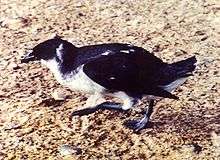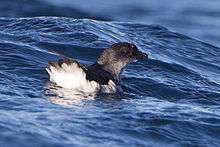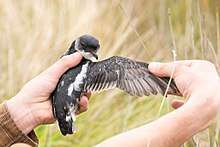Diving petrel
The diving petrels are seabirds in the bird order Procellariiformes. There are five very similar species all in the family Procellariidae and genus Pelecanoides (Lacépède, 1799), distinguished only by small differences in the coloration of their plumage, habitat, and bill construction. They are only found in the Southern Hemisphere. Some authorities place the diving petrels in their own family, the Pelecanoididae.[2]
| Diving petrel | |
|---|---|
 | |
| Peruvian diving petrel (Pelecanoides garnotii) | |
| Scientific classification | |
| Kingdom: | Animalia |
| Phylum: | Chordata |
| Class: | Aves |
| Order: | Procellariiformes |
| Family: | Procellariidae |
| Genus: | Pelecanoides Lacépède, 1799 |
| Species | |
|
Pelecanoides garnotii | |
Diving petrels are auk-like small petrels of the southern oceans. The resemblances with the auks are due to convergent evolution, since both families feed by pursuit diving, although some researchers have in the past suggested that the similarities are due to relatedness. Among the Procellariiformes the diving petrels are the family most adapted to life in the sea rather than flying over it, and are generally found closer inshore than other families in the order.
Diving petrels are plankton feeders, taking mostly crustacean prey such as krill, copepods and the amphipod Themisto gaudichaudii, also taking small fish and squid. They have several adaptations for obtaining their prey including short powerful wings, a gular pouch for storing food, and their nostrils open upwards rather than pointing forward as in other tubenoses.
Description and morphology
The diving petrels are small petrels that measure between 19–23 cm (7.5–9 in) and weigh 120–200 g (4.2–7.1 oz). They are highly uniform in appearance, and very difficult to distinguish when seen at sea. They are best distinguished by the size and shape of their short bills. The plumage is shining black on the top and white on the underside. Their wings are short, particularly with regards to overall body size, and used in a highly characteristic whirring flight. This flight is low over the water and diving petrels will fly through the crests of waves without any interruption of their flight path. In the water these wings are half folded and used as paddles to propel the bird after its prey.
Breeding
These birds nest in colonies on islands. One white egg is laid in a burrow in turf or soft soil that is usually covered with vegetation, feathers, or small rocks. They are nocturnal at the breeding colonies. It has a long period of parental care (around 45 to 60 days) in the burrow, but once the chick fledges out to sea it is on its own.
Status and conservation
Of the five species, two, the Peruvian diving petrel and the Magellanic diving petrel, have highly restricted ranges around South America's coasts, while the common diving petrel and the South Georgia diving petrel range widely across the southern oceans, breeding on islands off New Zealand, Subantarctic islands in the Indian Ocean, and islands in the south Atlantic (like Tristan da Cunha). One, the Whenua Hou diving petrel, has an extremely restricted range, breeding only on New Zealand's Codfish Island.[1]
Diving petrels are among the world's most numerous birds, with common and South Georgia diving petrels numbering several million pairs each. The Peruvian and Whenua Hou diving petrels, on the other hand, are highly threatened by guano extraction, introduced species and climate change, and are considered endangered species.
Systematics and evolution
Some studies published on the phylogeny of the petrels suggest that the diving petrels are actually members of the family Pelecanoididae, and some taxonomic works treat them as such.[2]
Extant Species
The five species are:
| Image | Scientific name | Common Name | Distribution |
|---|---|---|---|
 | Pelecanoides garnotii | Peruvian diving-petrel | Coasts and islands of Peru and Chile. |
| Pelecanoides magellani | Magellanic diving-petrel | Channels and fjords of southern Chile and Tierra del Fuego. | |
_(8365384976).jpg) | Pelecanoides georgicus | South Georgia diving-petrel | South Georgia and surrounding islets in the south Atlantic, and on the Prince Edward Islands, Crozet Islands, Kerguelen Islands and Heard Island and McDonald Islands in the southern Indian Ocean |
 | Pelecanoides urinatrix | Common diving-petrel | Most widespread species; found on New Zealand islands such as the Solander Islands, Snares Islands, Chatham Islands, Auckland Islands, Antipodes Islands, Campbell Island, islands off the Australia-administered Macquarie Island, and numerous islands off North Island; islands off southeast Australia and Tasmania, subantarctic islands of the Indian Ocean including the Prince Edward Islands, Crozet Islands, Kerguelen Islands, and Heard and McDonald Islands; in the Atlantic, it breeds at South Georgia, Tristan da Cunha Islands, Gough Island, Falkland Islands, and subspecies coppingeri assumed to breed in uncertain areas in Chile. |
 |
Pelecanoides whenuahouensis | Whenua Hou diving-petrel | Codfish, or Whenua Hou Island, New Zealand |
The evolution and systematics of these birds is not well researched. Several populations were described as distinct species and while most of them are only subspecies, some may indeed be distinct. The prehistoric fossil record was long limited to very fragmentary remains described as P. cymatotrypetes found in Early Pliocene deposits of Langebaanweg, South Africa; while this bird apparently was close to the common diving petrel, no members of the genus are known from South African waters today.[3]
In 2007, a humerus piece from New Zealand was described as P. miokuaka. This was found in Early/Middle Miocene deposits and just as may be expected, it far more resembles diving petrels than any other known bird, but presents a less apomorphic condition.[4]
Footnotes
- Fischer, Johannes H.; Debski, Igor; Miskelly, Colin M.; Bost, Charles A.; Fromant, Aymeric; Tennyson, Alan J. D.; Tessler, Jake; Cole, Rosalind; Hiscock, Johanna H. (2018-06-27). "Analyses of phenotypic differentiations among South Georgian Diving Petrel (Pelecanoides georgicus) populations reveal an undescribed and highly endangered species from New Zealand". PLOS ONE. 13 (6): e0197766. doi:10.1371/journal.pone.0197766. ISSN 1932-6203. PMC 6021066. PMID 29949581.
- Christidis, Les; Boles, Walter (2008). Systematics and taxonomy of Australian Birds. Collingwood, Vic: CSIRO Publishing. pp. 81–82. ISBN 978-0-643-06511-6.
- Olson (1985)
- Worthy, Trevor; Tennyson, Alan J. D.; Jones, C.; McNamara, James A.; Douglas, Barry J. (2007). "Miocene waterfowl and other birds from central Otago, New Zealand" (PDF). Journal of Systematic Palaeontology. 5 (1): 1–39. doi:10.1017/S1477201906001957. hdl:2440/43360. ISSN 1477-2019.
References
- Olson, Storrs L. (1985). "Section X.H.3. Pelecanoididae". In Farner, D. S.; King, J. R.; Parkes, Kenneth C. (eds.). Avian Biology. 8. New York: Academic Press. pp. 79–238.